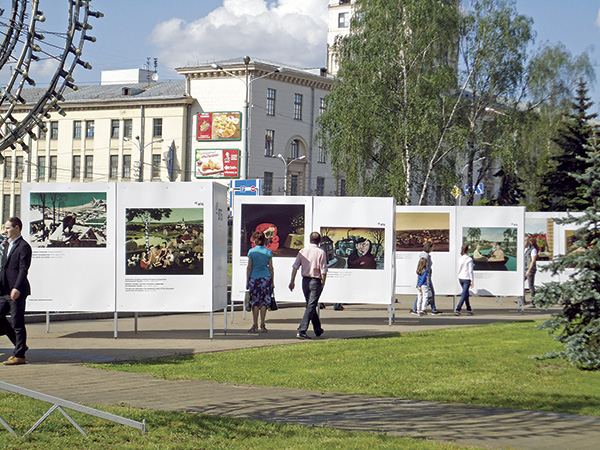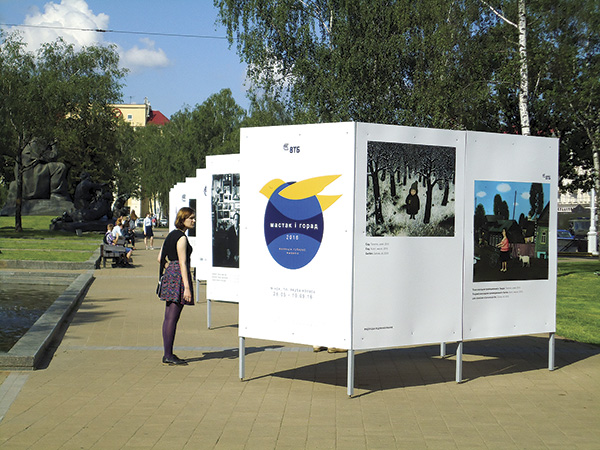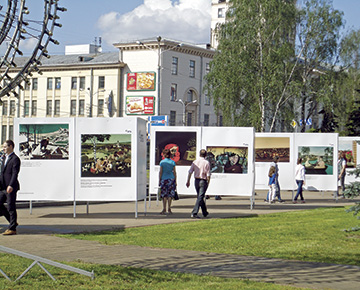Artist and the City project displays Valentin Gubarev’s creativity in Minsk
The open-air exhibition, Artist and the City, recently opened for the fifth time in Yakub Kolas Square in Minsk, dedicated to Valentin Gubarev’s work. The artist’s pictures have been gracing the halls of the famous French gallery Les Tournesols for more than twenty years, but are little known to Belarusian audiences.

Reproductions of thirty of Mr. Gubarev’s works are on show, with cards detailing his biography and information on particular pictures, in three languages: Russian, Belarusian and English.
Valentin Gubarev is a Belarusian painter, with an individual style, and a special vision of the world. His pictures often portray the everyday life of small provincial towns, using caricature to hint at hidden meanings.
One of the most prestigious French galleries, Les Tournesols, has displayed his works since 1995, and his canvases are on show at the National Art Museum of Belarus, the Zimmerli Art Museum in the USA, the Schaer und Wildbolz Gallery in Switzerland and Kunststuck Gallery in Germany, as well as in private collections throughout Russia, the UK, Japan, Spain, Israel and other states.
The Artist and the City project is being implemented with assistance from the Culture Ministry of Belarus and Minsk City Executive Committee and is initiated by GrandBS Social Marketing Agency and the National Centre of Contemporary Arts.

Artist and the City exhibition
Bank VTB has been the project’s general partner for two years. According to Sergey Doroshevich, Deputy Chairman of the Banks’ Board, the Artist and the City project has long gone beyond the borders of an exclusively open-air exhibition, becoming a calling card for the capital and a favourite place for Minskers to go to relax. Bank VTB takes its role of corporate social responsibility seriously, while paying attention to promoting awareness and enjoyment of contemporary Belarusian arts.
The Artist and the City project has promoted works by such famous painters as Marc Chagall and Kazimir Malevich, as well as works by late 20th century Belarusian avant-garde artist Nikolay Seleshchuk. Each year, more than 2 million people visit the exhibition, and will be admiring reproductions of Mr. Gubarev’s pictures until early September.
The master tells us that he was initially sceptical regarding the project but is now rightly proud. “There have been few such events for me, similar to my displaying my work at World EXPO in Shanghai. I’m proud of this, because Belarus has supported me, and Christie’s has bid on my works, which was delightful. I didn’t expect my picture to appear on the cover of their catalogue. I’m also proud that, over a period of 21 years, I’ve taught the French to take an interest in our country. They used to view us as something exotic but they’re now learning. I feel like a voluntary employee of the Foreign Ministry,” he jokes.

Mr. Gubarev, when did you start painting caricatures? What artistic experiments did you conduct beforehand?
My path has been typical for an artist: painting as a child, art studio, gesso ornaments, the Venus of Milo, Socrates, David, wax fruit and jar pieces, a stuffed magpie… My only wish was to paint things as they looked in real life.
Discovering the Impressionists and Post-impressionists had a big impact on me. Before entering the Graphic Arts Department of Moscow Polygraphic Institute, I tried, enthusiastically, to master the styles of Monet, Pissarro and Cézanne, then of van Gogh, Matisse and Renoir. Later on, I switched to the Cubists, Braque and Picasso. On entering university, Expressionism was my passion.
Now I understand that it was my way of self-educating and finding my own artistic charisma.
What inspires your portrayal of human life? Do you ride local transport, or watch people playing dominoes?
My characters are drawn from real life. Some lack happiness but they don’t suspect it to be so. I like people of this kind: simple and kind-hearted, ready to help and sympathise, unable to wear a double face or spin intrigue.
Women in your pictures are always plump. Is that personal taste?
I like females with curves, since this is what differentiates their figure from that of men. A woman should be womanly! I don’t depict models from catwalks who resemble ski sticks, but women I’ve met at the bank, on the metro or at a grocery store. I then add a little of the grotesque.
Mr. Gubarev, do foreigners find your artworks intriguing?
I’m a happy artist because I’ve never created anything to suit other people’s interests or tastes. In this respect, I’m absolutely irresponsible, as I only paint what I like myself. It’s a very honest and fervent process, like a warbler’s song. I address my viewers so that they recognise their homes, their fences, their first dates and the starry skies above their heads. Most importantly, they should recognise themselves. The homeland, to me, isn’t new trolley-buses or currency exchange offices. It’s something timeless, where people fall in love and are jealous, where fishermen sit in the fog on a riverbank, and where couples kiss on benches. This is the place where I spent my childhood and my youth. It’s very dear to me and I take my inspiration from these scenes. If I were born in the Caucasus, I’d paint mountains, and if I lived by the sea, I’d be a marine painter. It’s ecologically friendly art, based on deep personal feeling. Art is not sport or cooking. If you dig deep, you can achieve outstanding results. Otherwise, it’s like building a bridge without pylons, solving a sophisticated theorem or creating a new direction in painting. Levitan’s deep landscape work makes him unrivalled in the history of such art. You may paint flowers all your life and find fulfilment in this alone.
Artists often receive good orders following exhibitions, or news about sales at prestigious auctions. Do you paint to order or is this harmful to an artist, in your opinion?
I don’t like working to order. Perhaps, I’m just spoilt by opportunities to implement my ideas. To enjoy working on an order, you should love the theme as if it were your own, and this is not always the case. Yet, working to order itself doesn’t harm an artist. Conversely, it can enrich with new experience and help earn an income.
Your attitude is optimistic.
My philosophy is simple: life is short. Clear thoughts, right deeds and love in the heart make life worthwhile.
Tell us about your family. Are there other artists beside you?
I’m married and have two sons. The youngest has followed me, and has graduated from the Art Academy in the Czech Republic.
Mr. Gubarev is quite self-critical in speaking of himself and his work:
Sometimes, I ask myself if I should take a different artistic direction but I believe that, when you are original, you create a micro-cosmos. I hope that my works are eye-catching. I’m strongly convinced that art shouldn’t be too polished, since things fall off a glossy surface. Rough surfaces make you stop and look and then remember for longer.
By Veniamin Mikheev











